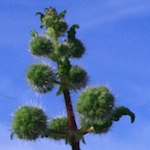Urtica pilulifera
Roman nettle Τσουκνίδα

Urticaceae - the nettle family Dicot.
Urtica pilulifera
Roman nettle Τσουκνίδα

Urticaceae - the nettle family Dicot.
The Mediterranean nettle, Urtica pilulifera, , is more vicious version of the common nettle, U. dioica, found in Northern Europe. Although it is a common weed, it has had many practical uses over the centuries; it has been used as a source of fibres and as a green dye; it was recommended by Hippocrates, as a medicine for a variety of ailments, and still features in many modern herbals. The nettle has been advocated for use as an internal elixir but also for external use; in a process known as urtification, the skin is stung by the nettles to give relief to arthritic pains.
The nettle is also recognised as a valuable food source and in Greece is made into a variety of tasty dishes including nettle pies, τσουκνιδόπιτα, and patties, κεφτεδάκια τσουκνίδας.
In Britain the plant is referred to as Roman nettle, as it was introduced by the Romans probably because of its medicinal value but it was said that the soldiers used to flagellate themselves to alleviate against the feeling of cold on their limbs.




Urtica from latin to sting or burn
pilulifera - botanical latin for bearing small globules or small balls